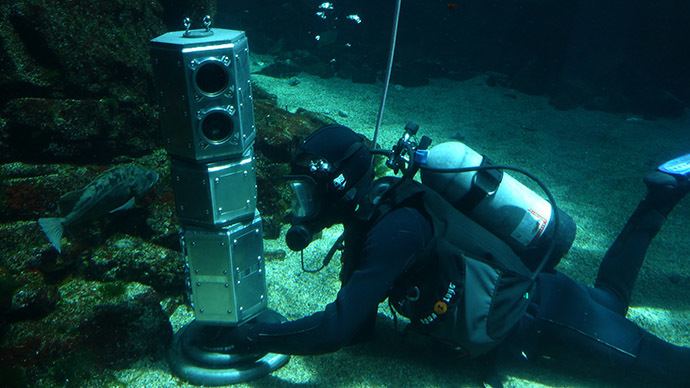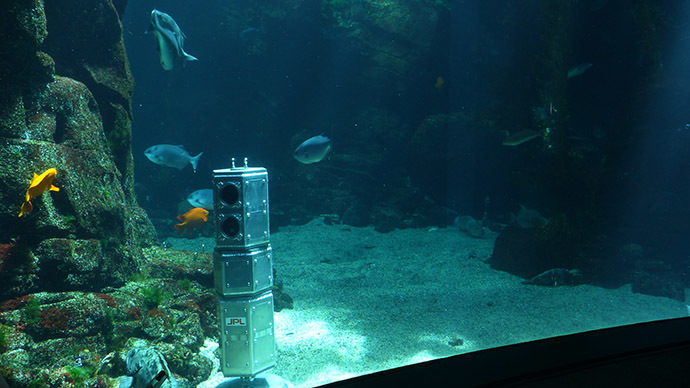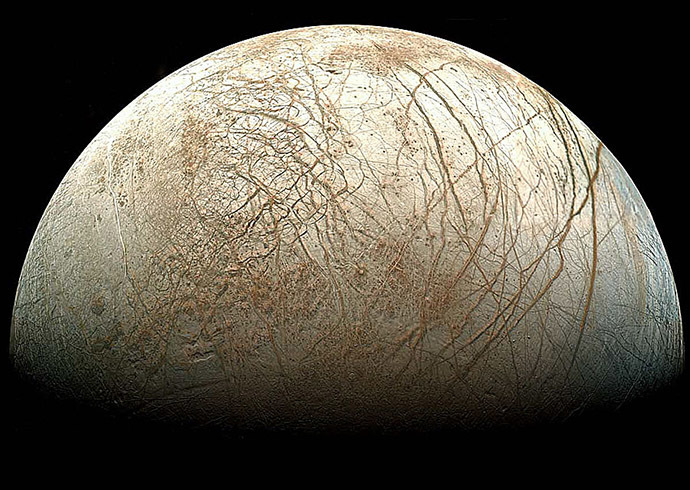NASA unveils rover prototype fit for exploring icy Europa moon (PHOTOS)

The US space agency has unveiled a prototype rover for exploring icy underwater regions. Scientists hope the rover may fly as far as Jupiter’s moon Europa, which has a vast subsurface ocean long thought to harbor life.
Called the Buoyant Rover for Under-Ice Exploration (BRUIE), the nifty tool comes packed with an array of sensors and instruments, as well as the same NASA software used in the Mars Cube One – the nano-spacecraft intended for fly-by surveys of the Red Planet in 2016. It will use a powerful laser to blast through thick ice and burrow its way inside.
At the moment, the thermos-looking machine is sitting at the bottom of the California Science Center’s 188,000-gallon aquatic tank in Los Angeles, but it will in future get wheels and be able to negotiate beneath icy surfaces as though it were on the ground.
The tool can already be used for exploring the Arctic and the Antarctic, but diver and principal investigator Andy Klesh of NASA’s Jet Propulsion Laboratory (JPL) has bigger plans for it, and they involve possibly the most eagerly awaited mission by the space agency after its success on Mars.
"A lot of what we do in deep space is applicable to the ocean," he says. "This is an early prototype for vehicles that could one day go to Europa and other planetary bodies with a liquid ocean covered by ice. It's ideal for traveling under the ice shelf of an icy world."

BRUIE is important in studying the interface between ice and water, researchers with the JPL explain.
"Our work aims to build a bridge between exploring extreme environments in our own ocean and the exploration of distant, potentially habitable oceans elsewhere in the solar system," co-investigator and planetary scientist at JPL, Kevin Hand, says.
Dan Berisford, John Leichty and Josh Schoolcraft at JPL are the other co-investigators on the rover project.
READ MORE: Search for life: NASA begins work on mission to Jupiter moon Europa
An early version of the device was tested underwater in 2012, on the inhospitable Matanuska glacier, in Alaska. The researchers made a hole in the ice and sent the rover underwater without so much as a tether. That is because the machine can be piloted remotely, and that was “the first time an under-ice vehicle had been operated via satellite,” Klesh says.
The new version is both longer and resistant to greater depths of about 200 meters (700 feet). It contains computers, sensors, communication equipment and a set of instruments for sampling and analyzing its surroundings.
Work is currently being done on increasing the rover’s autonomy, testing how it gathers data and takes photos.
"We're a long way off from exploring Europa's ocean, but the young children visiting the California Science Center and seeing our robot could be the ones building the vehicles that go there," Hand revealed.

Just a few days ago, NASA announced the mission to Europa is finally not a concept, but a real and workable idea.
Last week, NASA announced that its plan to survey Europa has been successfully reviewed by the agency and that it is now in the “formulation stage.”
“Europa is the most likely place to find life in our solar system today because we think there’s a liquid water ocean beneath its surface,” said Robert Pappalardo, a Europa mission project scientist, in a video released by NASA. “We know that on Earth, everywhere that there’s water, we find life. So could Europa have the ingredients to support life?”
READ MORE: Jupiter’s moon sprays water vapors 200km into air
Scientists witnessed back in 2013 Europa’s magnificent water vapors, shooting 200km up into the air.
The dominant theory, currently, is that this is caused by water eruptions on the surface of the icy moon. In combination with another study, which found minerals critical to life on the surface, scientists can begin to examine the interaction of chemicals above and below the moon’s surface.
In short, all the building blocks for life are there, but a closer look is required to understand their interaction. The hard part is getting underneath all that ice, presently thought to be 10-20 miles thick.
NASA is currently testing several technologies and devices that should allow advanced drilling and underwater exploring in the future. Just one of the 15 proposals in the agency’s foray into sci-fi territory is a squid-type underwater craft, conceptualized with Europa in mind.












